RMAA does the loop math too, you have to run a loopback and then you can subtract the loopback result from your DUT result.
So the additional cost is zero. It's just the card itself.
So the additional cost is zero. It's just the card itself.
Also, the question is how much to go the sound card route?
Depends what performance level you are going after.
It's going to be a lot more complicated as QA400 is pretty much all in one.
Your choice of USB audio interface is pretty much all in one.
If you try to use any signal generator, You need to do summing and subtraction to cancel out the harmonics from the signal generator.
Again, it depends what performance level you are going after. I believe that it has been pointed out that the eMu 0404 USB performs at about the same technical performance level as the QA400. No summing and subtraction is required to obtain residuals in the -110 dB range with either device.
How much it cost to rig up that. So what is the realistic cost of going to sound card route?
I picked up a complete eMu 0404 on eBay in the past year for well under $100. I see that right now there is one @ "Buy It Now" $89.95 Free Shipping. Caveat Emptor, it may be necessary to obtain its wall wart power supply and USB cord separately. The drivers and utilities can be obtained separately via download for no charge.
I know the QA400 is $199 plus a switch attenuator box. But the sound card route very likely need active circuits to get the job done.
False. Unlike the QA400, the sound card comes with balanced inputs and outputs. It may operate over a wider range of signal voltages. It can be used with a wide variety of software, some of which is good usable freeware.
Personally, I want one to get the job done, I don't really case what fancy option they have, I want to measure THD. If a stand alone box that is all in one to make life simpler, I'll go that route Unless I can do it with my laptop for half the cost of the QA400.
Depends what performance level you are going after. If you want to measure distortion down to the threshold of reliable human perception or well enough to develop tubed amps, a $29.95 Behringer UCA 202 can do the job. If you want an unending string of leading zeroes, nothing on the market today can help you.
Also, the question is how much to go the sound card route? It's going to be a lot more complicated as QA400 is pretty much all in one.
If you try to use any signal generator, You need to do summing and subtraction to cancel out the harmonics from the signal generator. How much it cost to rig up that. So what is the realistic cost of going to sound card route?
This is all part f the soundcard solution software like ARTA, TrueRTA, Visual Analyser, etc etc. All pretty much plug and play; you really should give that a spin before deciding.
Just install the software and use whatever 'sound card' is inside your computer, no external h/w necessary for a quick test.
Anyway, sound card h/w is pretty much the same as he QA400 h/w anyway.
Jan
Last edited:
Thanks Arnyk
Is this the right one?:S5L4B1 Emu EM8761 0404 USB Creative Professional USB MIDI Interface | eBay
I have no idea how this work.
1) Is this one connects to any computer including a laptop through USB?
2) This looks like the Presonus Audiobox USB I have already shown in post #11. how can this one work as spectrum analyzer to display the FFT?
3) If it is like my Presonus, there is no signal generator output to drive the amp to perform THD display.
Can you point me to articles how to make a THD analyzer out of this?
Thanks
Is this the right one?:S5L4B1 Emu EM8761 0404 USB Creative Professional USB MIDI Interface | eBay
I have no idea how this work.
1) Is this one connects to any computer including a laptop through USB?
2) This looks like the Presonus Audiobox USB I have already shown in post #11. how can this one work as spectrum analyzer to display the FFT?
3) If it is like my Presonus, there is no signal generator output to drive the amp to perform THD display.
Can you point me to articles how to make a THD analyzer out of this?
Thanks
This is all part f the soundcard solution software like ARTA, TrueRTA, Visual Analyser, etc etc. All pretty much plug and play; you really should give that a spin before deciding.
Just install the software and use whatever 'sound card' is inside your computer, no external h/w necessary for a quick test.
Anyway, sound card h/w is pretty much the same as he QA400 h/w anyway.
Jan
Do you mean just use the build in sound card in my laptop? Does it even have a sound card?
Is ARTA, TruRTA and Visual Analyzer free download?
Do you mean just use the build in sound card in my laptop? Does it even have a sound card?
Is ARTA, TruRTA and Visual Analyzer free download?
Of course it has a 'sound card' you can connect a mike and a headset, no? 🙂
I use my laptop that way all the time for a quick freq response or distortion plot.
Jan
Yes, then I have a sound card!!! ThanksOf course it has a 'sound card' you can connect a mike and a headset, no? 🙂
I use my laptop that way all the time for a quick freq response or distortion plot.
Jan
I have to look at the software. How am I going to generate the signal to drive the amp? Form the headphone output? Then the output of the amp driving back to the mic input?
Sorry that I don't know anything about this kind of stuff.
Thanks Arnyk
Is this the right one?:S5L4B1 Emu EM8761 0404 USB Creative Professional USB MIDI Interface | eBay
I have no idea how this work.
1) Is this one connects to any computer including a laptop through USB?
Yes.
2) This looks like the Presonus Audiobox USB I have already shown in post #11. how can this one work as spectrum analyzer to display the FFT?
Download one of the many freeware FFT programs, install it, configure it, and run it.
3) If it is like my Presonus, there is no signal generator output to drive the amp to perform THD display.
Sure there is. The Presonus has a line output, and you configure that to be your signal generator output.
Can you point me to articles how to make a THD analyzer out of this?
Thanks
This is my Presonus USB interface set up to run the Audio Rightmark program which is a good starting point.
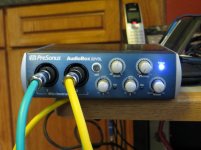
The Blue and Yellow wires run back to the TRS line out jacks on the back of the Presonus. You can crib the knob settings out of the enlargement of the photo.
The Rightmark program is configured like this:
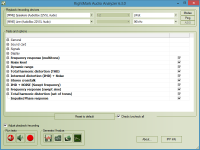 \
\All I had to do is select the input and output devices and sample rate, etc. shown in the top two lines.
I press the button with the red loudspeaker in the "Run tests box" and I set the level controls on the Presonus appropriately:
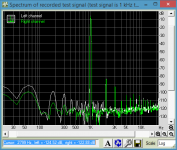
I press the "Start Test" Button which takes a minute or so to run the test and enters a dialog box to manage the test report.
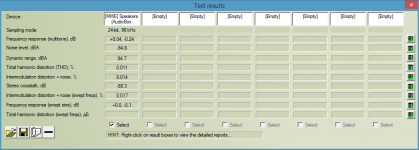
If I press one of the buttons on the right hand edge of the report management window, say for "Frequency Response" I get this:
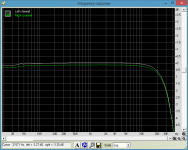
Once you get the Rightmark program working its easy to move up to more complicated programs like VA.
Thanks Arnyk
Holly smoke!! You mean I have the hardware to do the spectrum analyzer??!!
How good is the Presonus? It's only 48KHz sampling rate. Is it inferior? QA400 is 4 times the clock rate.
Ha ha, After I did the recording last year, I thought that's the end of the Presonus and I even put it in the garage already. Never thought I have more use of it.
I looked at your graph, it stopped at 20KHz, can you go beyond 20KHz as we usually look at the 20KHz sine wave and look at the harmonics.
Holly smoke!! You mean I have the hardware to do the spectrum analyzer??!!
How good is the Presonus? It's only 48KHz sampling rate. Is it inferior? QA400 is 4 times the clock rate.
Ha ha, After I did the recording last year, I thought that's the end of the Presonus and I even put it in the garage already. Never thought I have more use of it.
I looked at your graph, it stopped at 20KHz, can you go beyond 20KHz as we usually look at the 20KHz sine wave and look at the harmonics.
Last edited:
Thanks Arnyk
Holly smoke!! You mean I have the hardware to do the spectrum analyzer??!!
Yes.
How good is the Presonus? It's only 48KHz sampling rate. Is it inferior?
My Presonus was running @ 24/96 when I clipped those graphics. Its measured performance can be deduced from the screen shots.
Its good enough to develop audio gear that is sonically transparent, and works well with say Holme Impulse or Room Eq Wizard for acoustics and speaker testing.
Ha ha, After I did the recording last year, I thought that's the end of the Presonus and I even put it in the garage already. Never thought I have more use of it.
It will get you started and just might finish you up! Depends what your needs are... ;-)
Thanks Arnyk
I looked at your graph, it stopped at 20KHz, can you go beyond 20KHz as we usually look at the 20KHz sine wave and look at the harmonics.
It didn't stop @ 20 KHz, it just rolled off a bit. ;-)
When you need to measure high frequency nonlinearity, just use twin tones. You can pick the tones so that their difference is down at lower frequencies like 1 kHz.
You can use freeware programs like Audacity to create the test tones of your dreams and RMAA has a FFT mode for analyzing them.
Thanks Arnyk
Lot for me to take in. It's late, have to go to bed. I'll come back tomorrow.
Thanks
Lot for me to take in. It's late, have to go to bed. I'll come back tomorrow.
Thanks
...
If you want to go a step beyond the typical sound card, I suggest looking at Quaint Asylum's QA400.
Tom
Hi,
fwiw, that is a good tip, pretty much what I am looking for.
Which is, tubes and solid state audio electronics measurement.
Sounds simple....
What possible routes are there?
-Top Audio Analyzers are too expensive. And I don't need -140dB or whatever limit they can reach
-Dedicated 'vintage' hardware from HP or BK etc. is bulky, still cost a lot.
Can be troublesome if a repair is necessary.
And to roughly quote Quant ..even your $0.5 op amp can do better than the test equipment.' Also not very logical to operate, in many cases.
-New modern signal generators seem not to be audio suitable with 0,2% THD.
Yet the user interface is quite good and logical.... below 4 digit price tag. Might still be ok as speaker test signal source? Then again, software generators plus audio hardware easily surpass 0,2%THD
- The super low distortion oscillator from Vicnic is super, but only one frequency. Good as an additional super clean signal source, but not enough functionality to do full measurements.
-(USB) Audio Adapter or good sound card plus a software would be ok (for me) too. A little extra care for higher voltage signals. The configuration hassle and mouse click intensive software are the drawbacks.
So, the QA400 concept wins me over..
Best
Thomas
Last edited:
Thomas,
or wait for the upcomming http://www.diyaudio.com/forums/equipment-tools/277808-diy-audio-analyzer-ak5397-ak4490.html
😀
Hp
or wait for the upcomming http://www.diyaudio.com/forums/equipment-tools/277808-diy-audio-analyzer-ak5397-ak4490.html
😀
Hp
I had a Heathkit HD-1 distortion analyzer which I spruced up, only replacing the filter capacitor. It would measure distortion to less than 0.01% and cost me about $10. I also had the Heath 5248 IM analyzer which was very nice. On the other hand, I could never get the Eico distortion analyzer to work correctly. They do have a nice power transformer which will go into my "Equal Opportunity" phono amp.
Now I use the AP.
Now I use the AP.
The QA400 is as good as most sound cards are but integrates the source and SW bundled together....... good to -100dB and with an external notch filter it can measure lower with reasonable accuracy. The MFR is working on a more upscale version as well.
The unit mentioned in #34, above should work well as a DIY project... seperate source and SW required.
I too had to move beyond the sound card for many reasons and have a pretty large collection of distortion analyzer instruments now ($$$). But, the QA400 is fine for most situations. Even a tuned up HP 339A is suitable for most things..... but now their price has risen too high. But it can take input up to 300vac.
THx-RNMarsh
The unit mentioned in #34, above should work well as a DIY project... seperate source and SW required.
I too had to move beyond the sound card for many reasons and have a pretty large collection of distortion analyzer instruments now ($$$). But, the QA400 is fine for most situations. Even a tuned up HP 339A is suitable for most things..... but now their price has risen too high. But it can take input up to 300vac.
THx-RNMarsh
Contamination of signal grounds and varying output signal levels make straightforward soundcard measurements challenging sometimes, but the analytical power of the computer is well worthwhile. If you see one affordably, you can add a "front end" to the core analyzer, maybe something like an old Sound Technology 1700 series.
These can give you a differential input, breaking ground paths, a variable input sensitivity, and a good AC voltmeter. All stuff you'll need to get working somehow anyway. The Sound Tech's tend to be flaky in various ways, but usually not ways that affect this use, so maybe you can find one cheap. They also have a decent oscillator if it works.
All good fortune,
Chris
These can give you a differential input, breaking ground paths, a variable input sensitivity, and a good AC voltmeter. All stuff you'll need to get working somehow anyway. The Sound Tech's tend to be flaky in various ways, but usually not ways that affect this use, so maybe you can find one cheap. They also have a decent oscillator if it works.
All good fortune,
Chris
try to look for Spectralab.
It is very good.
Walter
Very, very good, but pricey!
There is a fair amount of extant software that would compete with it far more effectively if they would simply just let you load pre-existing .wav files.
Arta comes to mind about instantly.
- Status
- Not open for further replies.
- Home
- Design & Build
- Equipment & Tools
- How do you measure distortion?